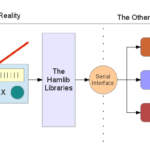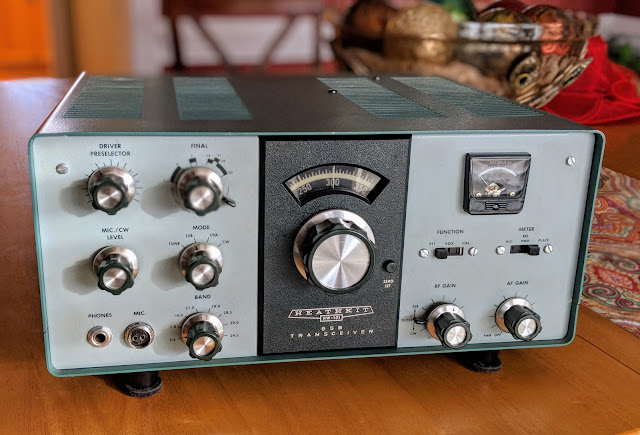 LHS Episode #206: Hamlib Deep Dive
LHS Episode #206: Hamlib Deep Dive
 Thanks for tuning into another episode of Linux in the Ham Shack. In this episode we take an in-depth look at the wonder of hamlib, the software that binds applications to your amateur radio hardware. It's cross platform, small, actively developed and wonderful in general. Hope you enjoy. Please make sure to send us your feedback about the topic, the show or just a quick hello.
Thanks for tuning into another episode of Linux in the Ham Shack. In this episode we take an in-depth look at the wonder of hamlib, the software that binds applications to your amateur radio hardware. It's cross platform, small, actively developed and wonderful in general. Hope you enjoy. Please make sure to send us your feedback about the topic, the show or just a quick hello.
73 de The LHS Crew
Russ Woodman, K5TUX, co-hosts the Linux in the Ham Shack podcast which is available for download in both MP3 and OGG audio format. Contact him at [email protected].
 Alexa Can Be Your Ham Shack Assistant!
Alexa Can Be Your Ham Shack Assistant!

Is Alexa your ham shack assistant? She has certainly become an indispensable addition to my shack.
Alexa is Amazon’s AI voice assistant. Alexa’s voice emanates from the several Amazon Echo products, like the Echo Dot, Echo Spot, Echo Show, Echo Plus, and Fire TV, among others to be announced.
Here are several Alexa related activated skills and applications that I have found especially useful in my ham shack, and you may find useful and fun to use in your shack, too. Some of these I use several times a day, while others I rarely use, and frankly, some of these applications are a bit of a challenge to get to work the way they should. So, you will discover that you have to ask Alexa just the right way; otherwise, she can get pretty uncooperative and frustrating!
Also, many of these services must be enabled before you can use them; for example, before you can use the Call Sign Skill, you need to say:
Alexa, enable Call Sign
Then, it should work just fine for you.
Now, here is a list of Alexa skills and applications you may find very helpful to use in your ham shack:
Alexa, what Time is it or simply: Alexa time
Alexa, what time is it in Mexico City — or any location of which you want the time
Alexa, what is the weather or simply Alexa weather
Alexa, what is the weather in Brisbane Australia — or any other QTH in which you want the weather
Alexa, what is the temperature or simply Alexa temperature
Alexa, what is the temperature in Key West — or any other QTH you request
Alexa, what is xx Fahrenheit in Celsius
(Note: great when in a QSO with stations using the metric system and you want to give them your temperature in Celsius instead of Fahrenheit)
Alexa, what is the 7 day forecast
Alexa, what is the 7 day forecast for Montpelier Vermont — or any other QTH you request
Alexa, open Weather Sky
(Note: this will give you a very in-depth weather report and forecast for your area, more than just asking for the weather in the previous commands)
Alexa open Weather Sky for Key West, Florida — or for any other QTH for which you want an in-dept weather report and forecast
Alexa, set a 10 minute timer
(Note: this is good for creating a station ID reminder)
Alexa, how many dollars are in 85 pounds
(Note: want to purchase an antenna from the UK where the price is in pounds? Use this quick conversion! This conversion works for many other currencies as well)
Alexa, what is xxx divided by yyy
(e.g. what is 468 divided by 3.8 to determine the length of a 75 m dipole)
Alexa, what is the distance between Bowling Green Kentucky and Quito Ecuador — or whatever qth you ask for
Alexa, how do you spell heterodyne — or whatever word you ask for
(Note: even though I am a Ph.D., I am a terrible speller and use this skill frequently)
Alexa, ask call sign who is K8HSY — or whatever call you want to know
(Note: often you have to use phonetics; I suggest using proper phonetics, e.g. kilo 8 Hotel Sierra Yankee)
Alexa, ask QRZ who is W7GPF — or whatever call you want
(Note: often you have to use phonetics; I suggest using proper phonetics, e.g. Whiskey 7 Golf Papa Foxtrot)
Alexa, ask ham look-up who is K8OEY — or whatever call you want
(Note: often you have to use phonetics; I suggest using proper phonetics, e.g. Kilo 8 Oscar Echo Yankee)
Alexa, Propagation report
Alexa, ask our ionosphere what are the current band conditions
Alexa, open space weather
Alexa, what time will the sun sit tomorrow
Note: great for gray line anticipation for DX
Alexa, what time will the sun rise tomorrow
Note: great for gray line anticipation for DX
Alexa, create a reminder to meet Tom for a schedule at 9 am Saturday morning — or any other reminder you need
Alexa, create a reminder to get on the Kentucky Phone Net every day at 5 pm in the afternoon — or any other everyday reminder you might need
Alexa, play the latest Ham Nation podcast — or any number of other ham-related podcasts
Alexa, use APRS and locate kilo 4 uniform lima echo
Note; works only for stations using the APRS system when you ask
Alexa, start extra ham cram
Note: gives you 7 different questions from the extra class pool to answer each time you execute the skill; good for exam prep. See how well you do!
Alexa, Open Amateur Radio test
Note: gives you several questions from the test pool to answer for fun or as a test prep
Alexa, Open Amateur Radio General Class Study
Alexa, Ask Ham Exam for a Question
Alexa, Open Ham Radio Facts
Note: gives you a different ham related fact each time you open it
Alexa, Open Q-code
Note: gives you a different Q-code each time you open it
Undoubtedly, I left a few out. There are new skills and applications becoming available about everyday; so many that it is impossible to keep up. If you know of any I left out that you use in your ham shack, please let me know. I am trying to maintain a reasonably complete file of ham shack useful skills and applications.
Dr. Ron Milliman is a special contributor to AmateurRadio.com and writes from Kentucky, USA. Contact him at [email protected].
 Weekly Propagation Summary – 2018 Jan 29 16:10 UTC
Weekly Propagation Summary – 2018 Jan 29 16:10 UTC
Here is this week’s space weather and geophysical report, issued 2018 Jan 29 0117 UTC.
Highlights of Solar and Geomagnetic Activity 22 – 28 January 2018
Solar activity was at very low levels. The largest event of the period was a B9 flare from plage Region 2696 (S13, L=123). No Earth-directed CMEs were observed.
No proton events were observed at geosynchronous orbit.
The greater than 2 MeV electron flux at geosynchronous orbit was at normal levels on 22-25 Jan and moderate levels from 26-28 Jan. A maximum flux of 348 pfu was observed at 27/2010 UTC.
Geomagnetic field activity was at predominately quiet to unsettled levels with an isolated active interval observed late on 24 Jan. Quiet to unsettled periods were observed on 22 Jan and 24-26 Jan due to a pair of weak negative polarity CH HSS. Quiet levels were observed on 23 Jan and 27- 28 Jan.
Forecast of Solar and Geomagnetic Activity 29 January – 24 February 2018
Solar activity is expected to be at very low levels throughout the outlook period.
No proton events are expected at geosynchronous orbit.
The greater than 2 MeV electron flux at geosynchronous orbit is expected to be at normal to moderate levels throughout the outlook period.
Geomagnetic field activity is expected to be at quiet to unsettled levels on 29-31 Jan, 04-05 Feb, 09-11 Feb, 15-18 Feb and 20-22 Feb, with isolated active periods likely on 10 Feb. This activity is due to influence from recurrent CH HSSs. Mostly quiet conditions are expected for the remainder of the outlook period.
Don’t forget to visit our live space weather and radio propagation web site, at: http://SunSpotWatch.com/
Live Aurora mapping is at http://aurora.sunspotwatch.com/
If you are on Twitter, please follow these two users: 1. https://Twitter.com/NW7US 2. https://Twitter.com/hfradiospacewx
Check out the stunning view of our Sun in action, as seen during the last five years with the Solar Dynamics Observatory (SDO): https://www.youtube.com/watch?v=zXN-MdoGM9g
= = = = =
BOOK SALE: Space Weather and Sun Science – get these from Amazon, and help us stay online!
NOTICE: When you buy this (or any item after starting with this link), you are helping us keep our SunSpotWatch.com and other resources “on the air” (up and running!). In other words, you are helping the entire community. So, check out this book:
Here is the link to Amazon: http://g.nw7us.us/fbssw-aSWSC
We’re on Facebook: http://NW7US.us/swhfr
Visit, subscribe: NW7US Radio Communications and Propagation YouTube Channel
 Before transistors there were TUBES
Before transistors there were TUBES
Oh Boy, what have I gotten myself into
 |
| TUBES |
 |
| Heathkit HP-13a |
Heathkit HW-101
 |
| Heathkit HW-101 |
 |
| Crystal filter |
Richard Carpenter, AA4OO, is a regular contributor to AmateurRadio.com and writes from North Carolina, USA. Contact him at [email protected].
 Amateur Radio Weekly – Issue 191
Amateur Radio Weekly – Issue 191
AO-92 commissioned, open for Amateur use
Initially, the U/v FM transponder will be open continuously for a period of one week. After the first week, operations will be scheduled among the U/v FM transponder, L-Band Downshifter, Virginia Tech Camera, and the University of Iowa’s High Energy Radiation CubeSat Instrument (HERCI).
AMSAT
Blinded by the light: The solar panel tariff
There are a few things off grid amateur radio operators need to know about the solar panel tariff.
Off Grid Ham
PicSat requests Ham Radio assistance to capture telemetry
The CubeSat PicSat carrying an amateur radio FM transponder was launched on the same PSLV-C40 flight from India that delivered AO-92 to orbit.
AMSAT UK
A better antenna for dualband handhelds
Recently, I wondered how well the antenna is really performing so I did a side-by-side comparison with the Smiley 2m halfwave.
AmateurRadio.com
Massive 78-year-old transmitter for sale
A piece of radio history could be yours for $5,000. A 1940 RCA 50 kW shortwave transmitter, located at the decommissioned Radio Canada International Site in Sackville, is up for sale.
CBC
A grave threat to GPS
In the coming months, the U.S. Federal Communications Commission (FCC) may allow high-powered, ground-based, communication transmitters to broadcast at a frequency near GPS L1.
GPS World
Visualizing satellite doppler shift
Doppler Shift is experienced as the satellite (wave source) is moving relative to you, the observer (or receiver) of the transmitted wavelength.
N1AAE
Do shortwave ‘Numbers Stations’ really instruct spies?
Today, numbers stations remain a reality on shortwave radio, even in the Internet Age.
Radio World
Video
Pre-planning for the ARRL VHF Contest
KB1HQS
Indoor attic dipole antenna
Trying out an antenna for Ham Radio in the attic.
K5ACL
Amateur Radio Weekly is curated by Cale Mooth K4HCK. Sign up free to receive ham radio's most relevant news, projects, technology and events by e-mail each week at http://www.hamweekly.com.
 LHS Episode #205: The Weekender II
LHS Episode #205: The Weekender II
 Welcome to the another edition of The Weekender version of LHS. In this episode, your hosts discuss, Scotch whisky, cheap wine, JT-65, casseroles with pepperoni and awesome, upcoming contests and special event stations and much more. Thank you for listening.
Welcome to the another edition of The Weekender version of LHS. In this episode, your hosts discuss, Scotch whisky, cheap wine, JT-65, casseroles with pepperoni and awesome, upcoming contests and special event stations and much more. Thank you for listening.
73 de The LHS Crew
Russ Woodman, K5TUX, co-hosts the Linux in the Ham Shack podcast which is available for download in both MP3 and OGG audio format. Contact him at [email protected].
 TX factor Episode 20 is Now On Air
TX factor Episode 20 is Now On Air
Welcome to our 20th episode! In this revamped show we conclude our look at innovative amateur radio products from UK National Hamfest 2017, and Bob goes back to basics with an overview of setting up an inexpensive SDR dongle. We have two great prizes to give away in our free-to-enter draw. An RSP1A SDR receiver from SDRplay and a copy of the best-selling book ‘SDR’ from the RSGB. Plus we look back at the past four years of topics covered by the TX Factor team. We hope you enjoy it!
Nick Bennett 2EØFGQ co-hosts TX Factor with Bob McCreadie GØFGX and Mike Marsh G1IAR. Contact the team at [email protected]















